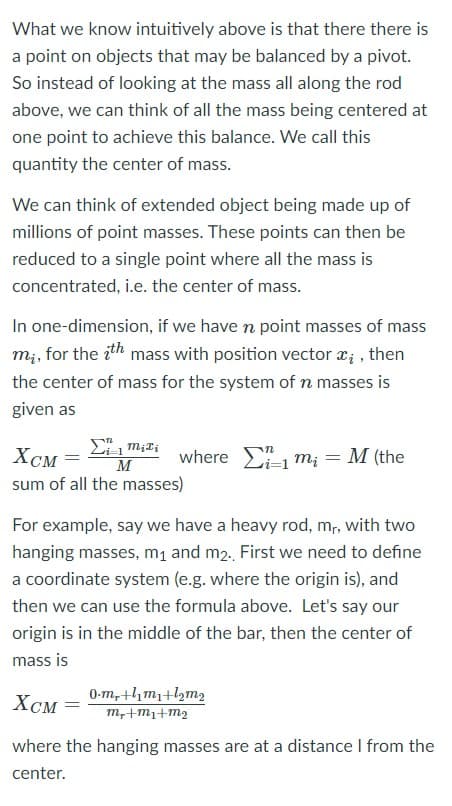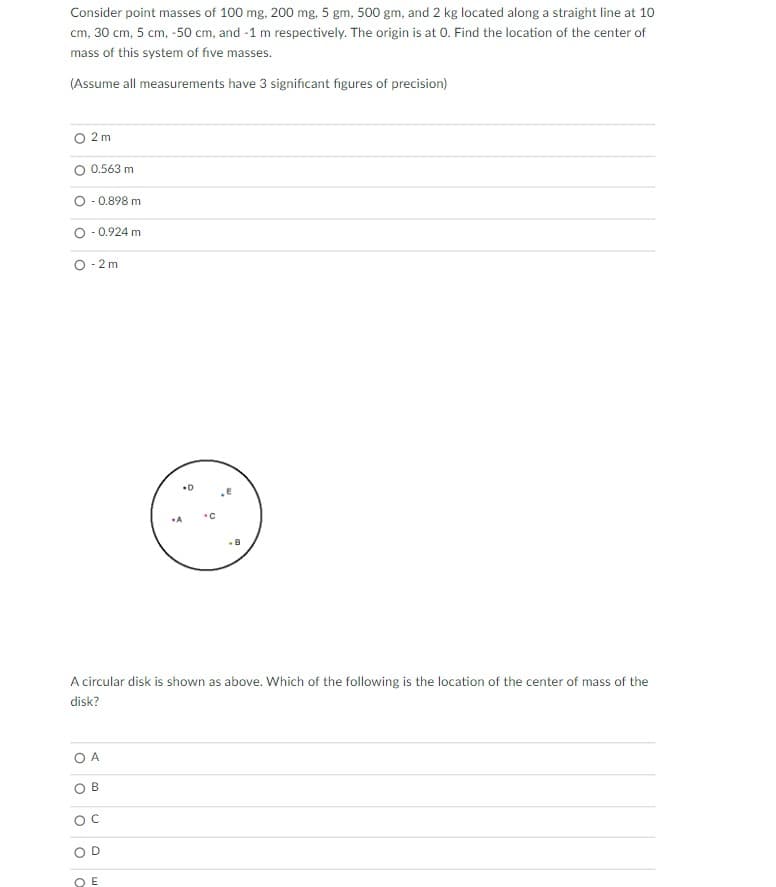Principles of Physics: A Calculus-Based Text
5th Edition
ISBN:9781133104261
Author:Raymond A. Serway, John W. Jewett
Publisher:Raymond A. Serway, John W. Jewett
Chapter10: Rotational Motion
Section: Chapter Questions
Problem 5OQ: Assume a single 300-N force is exerted on a bicycle frame as shown in Figure OQ10.5. Consider the...
Related questions
Question
this is ONE question, please answer both short parts. Thank you.

Transcribed Image Text:What we know intuitively above is that there there is
a point on objects that may be balanced by a pivot.
So instead of looking at the mass all along the rod
above, we can think of all the mass being centered at
one point to achieve this balance. We call this
quantity the center of mass.
We can think of extended object being made up of
millions of point masses. These points can then be
reduced to a single point where all the mass is
concentrated, i.e. the center of mass.
In one-dimension, if we have n point masses of mass
m;, for the ith mass with position vector x; , then
the center of mass for the system of n masses is
given as
Хсм
XCM =
where E m; = M (the
M
sum of all the masses)
For example, say we have a heavy rod, m, with two
hanging masses, m, and m2. First we need to define
a coordinate system (e.g. where the origin is), and
then we can use the formula above. Let's say our
origin is in the middle of the bar, then the center of
mass is
XCM =
0-m, thm1+l2m2
m,+m1+m2
where the hanging masses are at a distance I from the
center.

Transcribed Image Text:Consider point masses of 100 mg, 200 mg, 5 gm, 500 gm, and 2 kg located along a straight line at 10
cm, 30 cm, 5 cm, -50 cm, and -1 m respectively. The origin is at 0. Find the location of the center of
mass of this system of five masses.
(Assume all measurements have 3 significant figures of precision)
2 m
0.563 m
O - 0.898 m
- 0.924 m
O - 2 m
A
-8
A circular disk is shown as above. Which of the following is the location of the center of mass of the
disk?
O A
O E
Expert Solution
This question has been solved!
Explore an expertly crafted, step-by-step solution for a thorough understanding of key concepts.
Step by step
Solved in 3 steps with 1 images

Knowledge Booster
Learn more about
Need a deep-dive on the concept behind this application? Look no further. Learn more about this topic, physics and related others by exploring similar questions and additional content below.Recommended textbooks for you

Principles of Physics: A Calculus-Based Text
Physics
ISBN:
9781133104261
Author:
Raymond A. Serway, John W. Jewett
Publisher:
Cengage Learning

University Physics Volume 1
Physics
ISBN:
9781938168277
Author:
William Moebs, Samuel J. Ling, Jeff Sanny
Publisher:
OpenStax - Rice University

Glencoe Physics: Principles and Problems, Student…
Physics
ISBN:
9780078807213
Author:
Paul W. Zitzewitz
Publisher:
Glencoe/McGraw-Hill

Principles of Physics: A Calculus-Based Text
Physics
ISBN:
9781133104261
Author:
Raymond A. Serway, John W. Jewett
Publisher:
Cengage Learning

University Physics Volume 1
Physics
ISBN:
9781938168277
Author:
William Moebs, Samuel J. Ling, Jeff Sanny
Publisher:
OpenStax - Rice University

Glencoe Physics: Principles and Problems, Student…
Physics
ISBN:
9780078807213
Author:
Paul W. Zitzewitz
Publisher:
Glencoe/McGraw-Hill